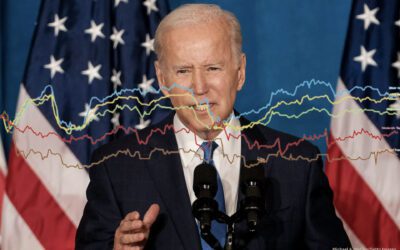A major new study conducted by Democracy Corps and Women’s Voices. Women Vote Action Fund demonstrates the strength of a new progressive narrative leading into the 2016 Election Year. This narrative puts a middle class agenda at the center of the economic debate, but it begins with an embrace of reform: reform of both politics and government. It argues for systematic changes in how we elect our representatives (political reform) and also critical changes in our governance (government reform) that roots out waste and gets voters their money’s worth.[1]
With two thirds believing the country is on the wrong track, voters are determined to see change – and that includes the economic status quo, the state of working families and the middle class, the corrupted political process and failed government.
This message is tested on the cusp of what could be a historic election for the Democratic Party. Hillary Clinton holds a large and stable lead over Donald Trump (currently 8 points, with Clinton flirting with a majority), built largely on overwhelming support among Rising American Electorate (RAE) voters—unmarried women, people of color, and millennials. Democrats face two major challenges. First, the Democrats’ potential base of support is decidedly less enthusiastic about politics and voting than conservatives. Second, support for Democratic candidates for the Senate and House and down-ballot is pretty unimpressive, given the tarnished Republican brand. And that underperformance is particularly true for the RAE voters who are struggling and want to see change. For example, Clinton reaches 65 percent among all RAE voters in the trial heat against Trump, compared to just 58 percent for congressional Democrats in a named congressional trial heat.
The critical piece to this research is this: the message previewed above addresses these two challenges. It produces big increases in the enthusiasm among RAE voters; it also produces a significant shift toward the Democrats, not only among RAE voters, but among swing voters as well.
Strength at the top of the ticket does not translate
The Republican brand is thoroughly tarnished as that Party has not kept pace with an America changing culturally and demographically. While Trump (64 percent unfavorable) has done real violence to perceptions of the GOP, it also true that the congressional Republican leadership drew high negatives before Trump burst on the scene. Disaffection from this party will likely outlive Trump even if he fails to win the nomination.
The result? Despite the historical challenge of winning a “third term” and being perceived as the incumbent party in a majority wrong track electorate, Democrats enjoy a 50 – 42 percent lead at the top-of-the-ticket against Trump. The foundation of this lead rests with voters in the RAE, including unmarried women (71 percent Clinton), millennial voters (69 percent) and people of color (75 percent). Clinton also leads with Independents voters and is competitive among white, working class women, both of which President Obama lost.
If the voters in the RAE turn out in 2016, Hillary Clinton will make history. However, only 56 percent of RAE voters rate themselves extremely enthusiastic about voting next year (ten on a ten-point scale), compared to 72 percent among non-RAE voters. Among millennial voters, this number drops to 43 percent. The other challenge Democrats face is down-ballot. Congressional Democrats manage only a 2-point margin in a named trial heat. Most of the disparity with top-of-the-ticket reflects insufficient congressional support among RAE voters. There is a huge opportunity here – if Democratic candidates give people a reason to vote.

A new, powerful middle class reform narrative addresses both Democrats’ enthusiasm problem and moves Democratic down-ballot support closer to where it needs to be to pull off a historic election.
The middle class political and government reform message
This survey is the only national instrument we are aware of that combines a core Democratic economic narrative with a powerful message of reform of both our politics and our government. It really opens up voters and puts Republicans on the defensive. It is also feels like common sense: of course, people who are struggling financially want their votes and tax money to count.
A 62 percent majority of voters react positively to this message, 41 percent much more positive. This jumps to 72 percent among RAE voters, and 75 percent (51 percent much more positive) among unmarried women. This message also finds traction among Independents (60 percent positive) and other contested voters (65 percent among white non-college women). A Republican message does less well (54 percent total positive) and with less intensity (just 35 percent much more positive).

Democrats enjoy support for a wide variety of specific reforms that address both politics and governance. The strongest reform pledges to end secret money that is corrupting our politics. Nearly as many voters, however, react strongly to governmental reforms, such as cracking down on Medicare fraud and auditing the federal government for waste.

The impact of this messaging
Even when paired and balanced against a Republican statement, the messaging above accomplishes two important tasks for the Democrats. It increases the enthusiasm of RAE voters and it improves their electoral position down-ballot.
After voters hear this message, 62 percent of RAE voters describe themselves as very enthusiastic about voting in 2016, up from 56 percent. The message produces a 10-point increase among millennials and also an outsized impact among unmarried women.

It is typically very difficult to create significant movement in a balanced message exercise, particularly given the deep partisan polarization of voters. Nonetheless, this messaging doubles the Democratic margin at the congressional level (to 48 – 44 percent Democratic). Democratic support grows by three points among RAE voters (to 63 percent, close to Clinton’s 65 percent number). The reform message also generates small, but significant gains among swing voters including a 3 point shift among white working class women (to 45 – 48 percent Republican).
Conclusion
In March, 2013, the national wrong track number slipped back over 60 percent and at least 60 percent of voters of described the country as headed for the rocks ever since. Candidates in contested elections who do not come to the table with a credible message of reform and change will not survive this kind of environment. The message outlined above combines a core progressive economic message with a powerful statement on reforming our politics and our government. This marriage of frames produces significant changes in the electorate that, if fully realized, could lead to a historic Democratic election in 2016.
[1] This survey took place December 5-9, 2015 among respondents who voted in the 2012 election or registered since. Respondents were selected from the national voter file. Likely voters were determined based on stated intention of voting in 2016. Margin of error for the full sample = +/-3.27 percentage points at 95% confidence. Margin of error will be higher among subgroups. Sixty percent of respondents were reached by cell phone, in order to account for ever-changing demographics and accurately sample the full American electorate.




